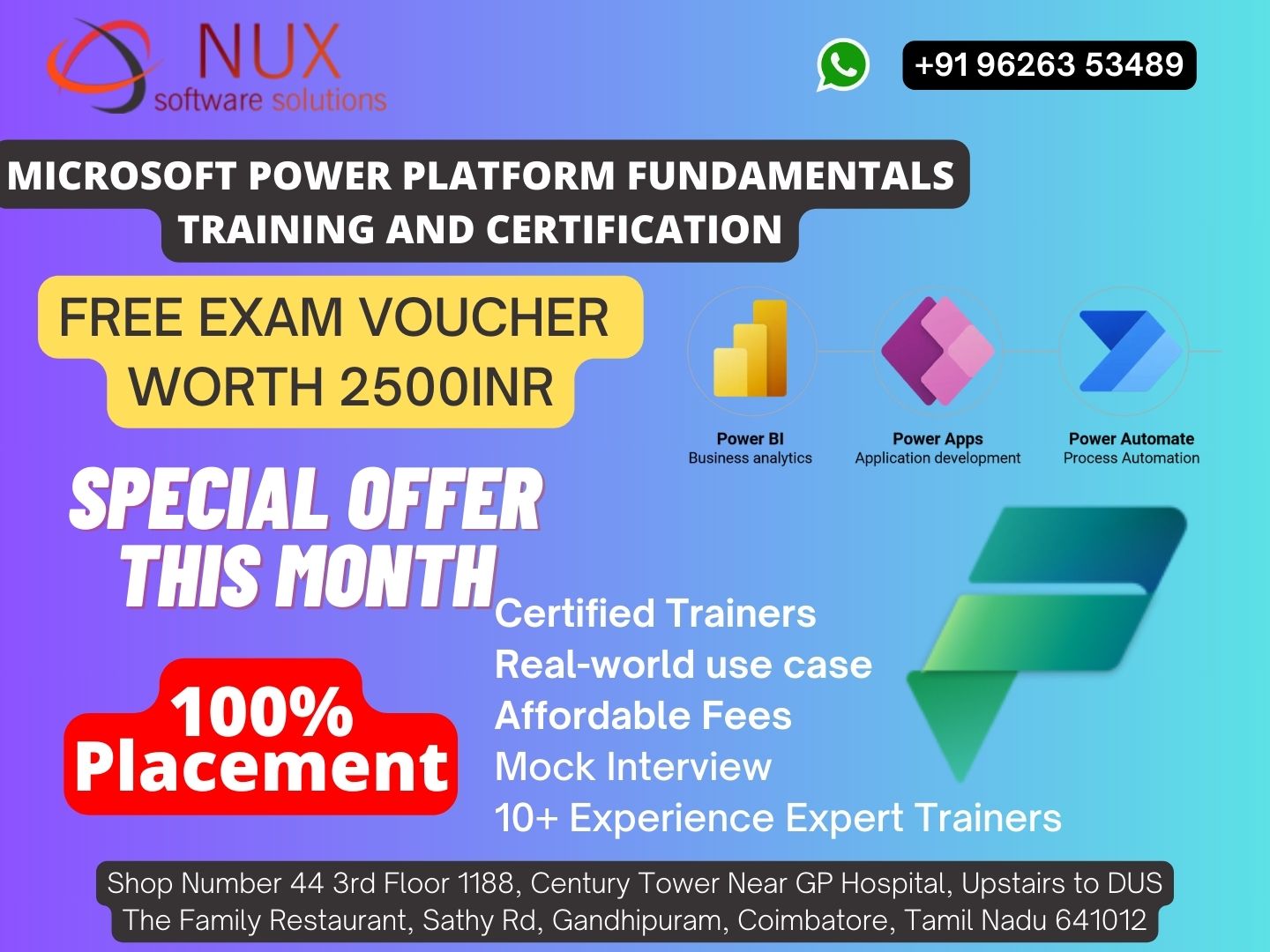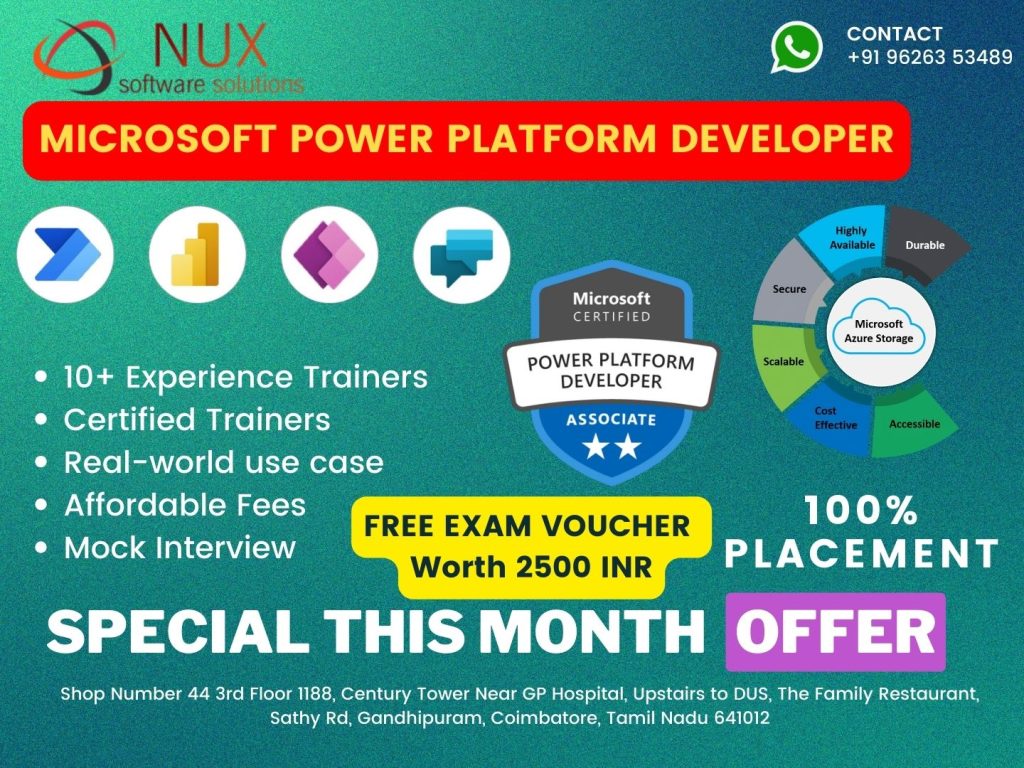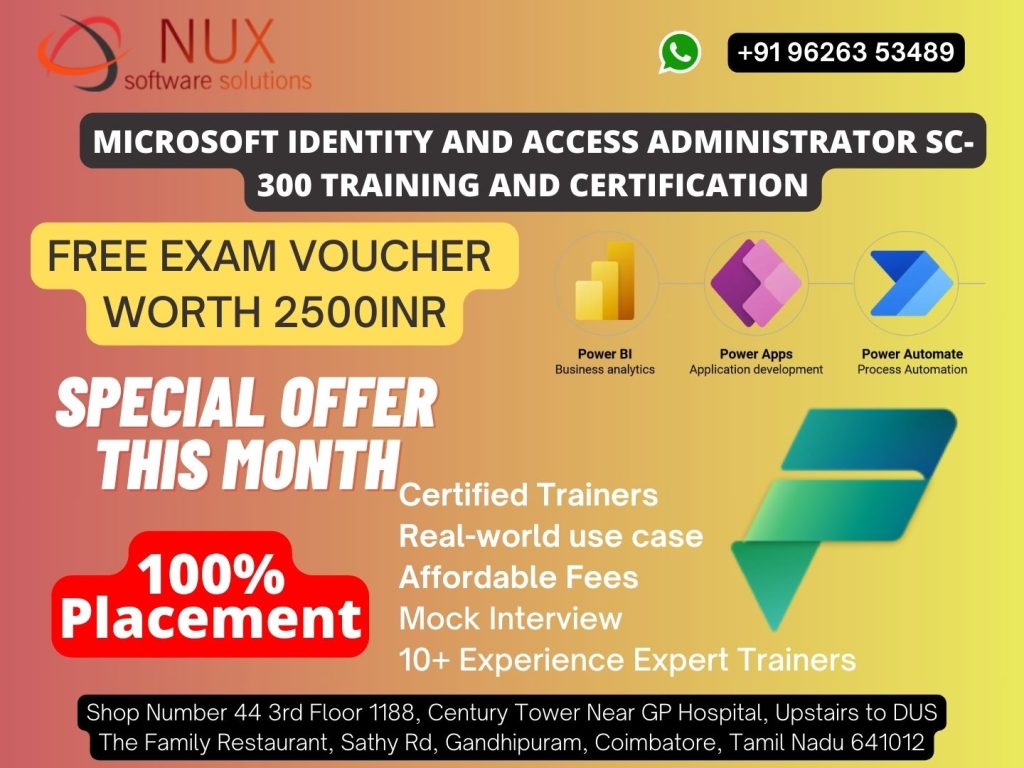Microsoft Power Platform Fundamentals PL-900

Microsoft Power Platform Fundamentals (PL-900) Training and Certification in Coimbatore
Start your journey in low-code application development and business automation with the Microsoft Power Platform Fundamentals (PL-900) Training in Coimbatore. This beginner-friendly course is perfect for individuals and organizations seeking to understand the core capabilities of Microsoft Power Platform — including Power Apps, Power Automate, Power BI, and Power Virtual Agents.
The PL-900 certification helps you gain foundational knowledge to build simple apps, automate tasks, and analyze data, making it an excellent starting point for business users, IT professionals, and decision-makers who want to digitize and streamline business operations.
Why Choose This Course?
Beginner-Friendly – No prior technical experience required
Microsoft-Certified Curriculum aligned with the PL-900 exam
Hands-On Learning using real tools and data sets
Build a Strong Foundation in Power Platform components
Perfect for Business Users, Students, and Aspiring App Makers
What You Will Learn
Overview of Power Platform components and capabilities
Creating basic apps with Power Apps
Automating processes with Power Automate
Building interactive dashboards using Power BI
Understanding Power Virtual Agents for chatbot creation
Core concepts of data connectors, Microsoft Dataverse, and AI Builder
Identifying use cases and business value of Power Platform solutions
Who Should Enroll?
Business users looking to automate repetitive tasks
Students and professionals entering the Microsoft ecosystem
Decision-makers evaluating Microsoft Power Platform
Non-technical users seeking to understand digital transformation
Candidates preparing for the PL-900 certification exam
Course Features
Instructor-led sessions with hands-on Power Platform practice
Access to real-time labs and interactive learning environment
Mock tests, exam tips, and certification preparation
Certificate of completion and career advice
Flexible learning modes – Online and Offline
Begin your Microsoft certification journey with confidence. Enroll in the Microsoft PL-900 Power Platform Fundamentals Training in Coimbatore and gain the skills to bring automation and data insights to life — no coding required.
Microsoft Power Platform Fundamentals Syllabus
Modules
Describe the business value of Microsoft Power Platform (20-25%)
- Describe the value of Power Apps to build applications
- Describe the value of Power Automate to automate processes
- Describe the value of Power BI to gain insights into data
- Describe the value of Power Pages to build websites
- Describe the value of Power Virtual Agents to create chatbots
- Describe the value of connectors to integrate services and data
- Describe the value of Microsoft Dataverse to organize business data
- Describe the value of AI Builder to enhance apps and flows
- Describe how Microsoft Power Platform apps work together with Microsoft Dynamics 365 apps
- Describe how Microsoft Power Platform business solutions work together with Microsoft 365 apps and services
- Describe how Microsoft Power Platform apps work together
- Describe how Microsoft Power Platform works with Microsoft Teams
- Describe how Microsoft Power Platform business solutions can consume Microsoft Azure services
- Describe the Microsoft Power Platform security model
- Describe environments
- Describe where to perform specific administrative tasks including Microsoft Power Platform admin center and Microsoft 365 admin center
- Describe how Microsoft Power Platform supports privacy and accessibility guidelines
Identify foundational components of Microsoft Power Platform (10-15%)
- Describe differences between traditional databases and Microsoft Dataverse
- Describe tables, columns, and relationships in Microsoft Dataverse
- Describe business logic in Microsoft Dataverse
- Describe dataflows for Microsoft Dataverse
- Describe the components of a connector
- Describe standard and premium connectors
- Identify use cases for custom connectors
Demonstrate the capabilities of Power BI (10-15%)
- Describe Power BI Desktop and Power BI Service
- Compare and contrast dashboards, workspaces, reports, and paginated reports
- Describe how to clean and transform data by using Power Query
- Describe how AI Insights helps identify anomalies and trends in data
- Create a Power BI report by adding visualizations
- Create a Power BI dashboard
- Add visualizations to dashboards by using Q&A
- Consume Power BI reports and dashboards
Demonstrate the capabilities of Power Apps (20-25%)
- Describe the differences between canvas apps and model-driven apps
- Describe use cases for and capabilities of canvas apps
- Describe use cases for and capabilities of model-driven apps
- Connect to data sources by using connectors
- Create an app from data
- Add controls to canvas app screens
- Create a model-driven app from tables
- Modify forms
- Create and modify views
Demonstrate the capabilities of Power Automate (15-20%)
- Describe use cases for cloud and desktop flows
- Describe use cases for cloud flow templates
- Describe how Power Automate cloud flows use connector triggers and actions
- Describe Power Automate use cases for approvals, Microsoft Teams, Outlook, SharePoint, and Forms
- Describe the Power Automate apps including Power Automate for Desktop, Power Automate mobile, and the Power Automate portal
- Describe actions for Power Automate desktop flows
- Describe document processing in Power Automate
- Create a cloud flow by using an instant, automated, or scheduled flow template
- Modify a cloud flow
- Add flow steps to perform data operations
- Run a cloud flow
- Build a basic desktop flow by recording tasks
Describe complementary Microsoft Power Platform solutions (15-20%)
- Describe use cases for Power Virtual Agents
- Describe the purpose of topics, entities, and actions
- Create topics from existing FAQs by using Suggest Topics
- Describe use cases for Power Pages
- Describe use cases for templates
- Describe how to share data externally
- Describe use cases for AI Builder, including Sentiment Analysis and receipt processing
- Describe the lifecycle to create an AI Builder model
To ensure success in Microsoft Power Platform Fundamentals certification exam, we recommend authorized training course, practice test and hands-on experience to prepare for Microsoft Power Platform Fundamentals (PL-900) exam.



